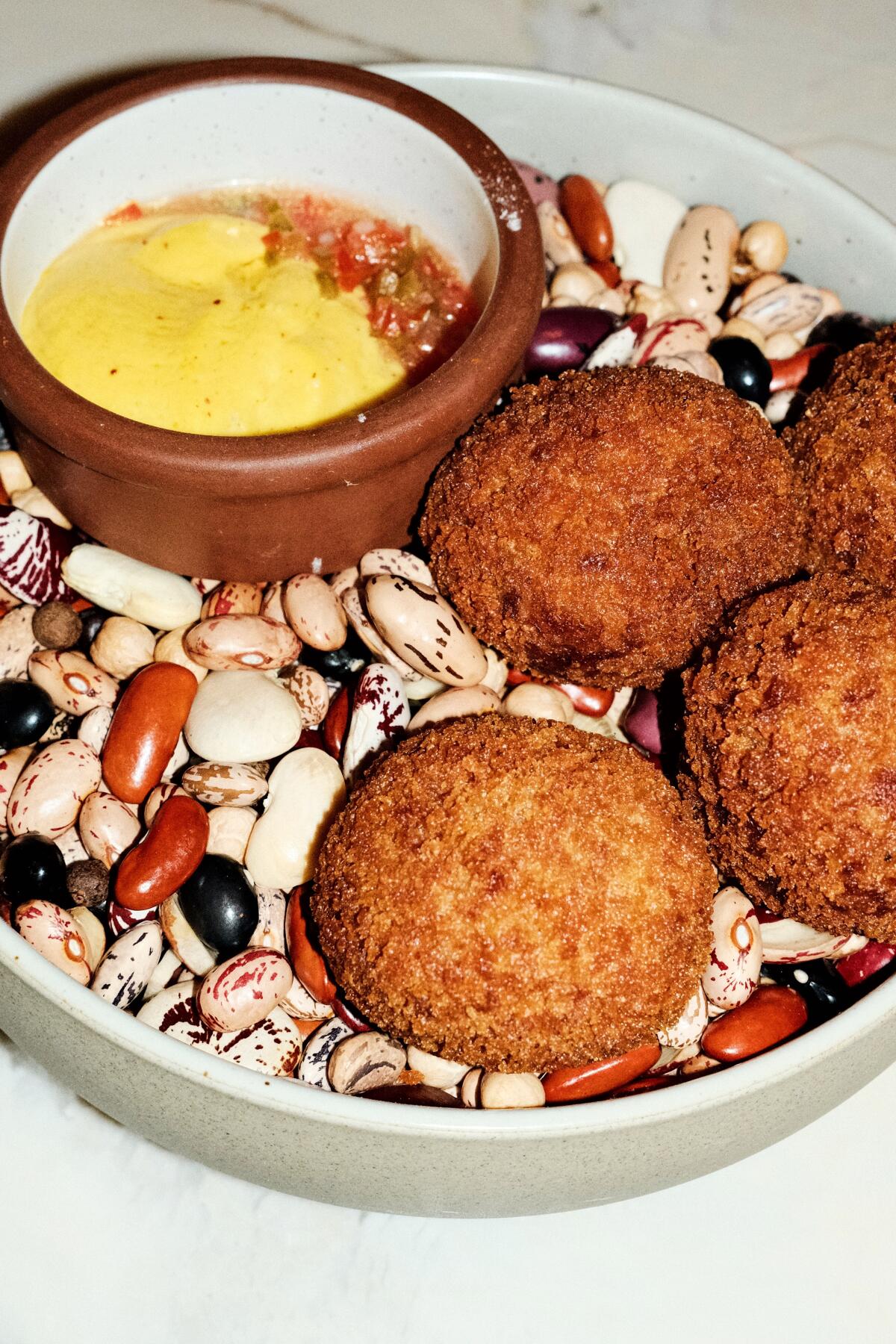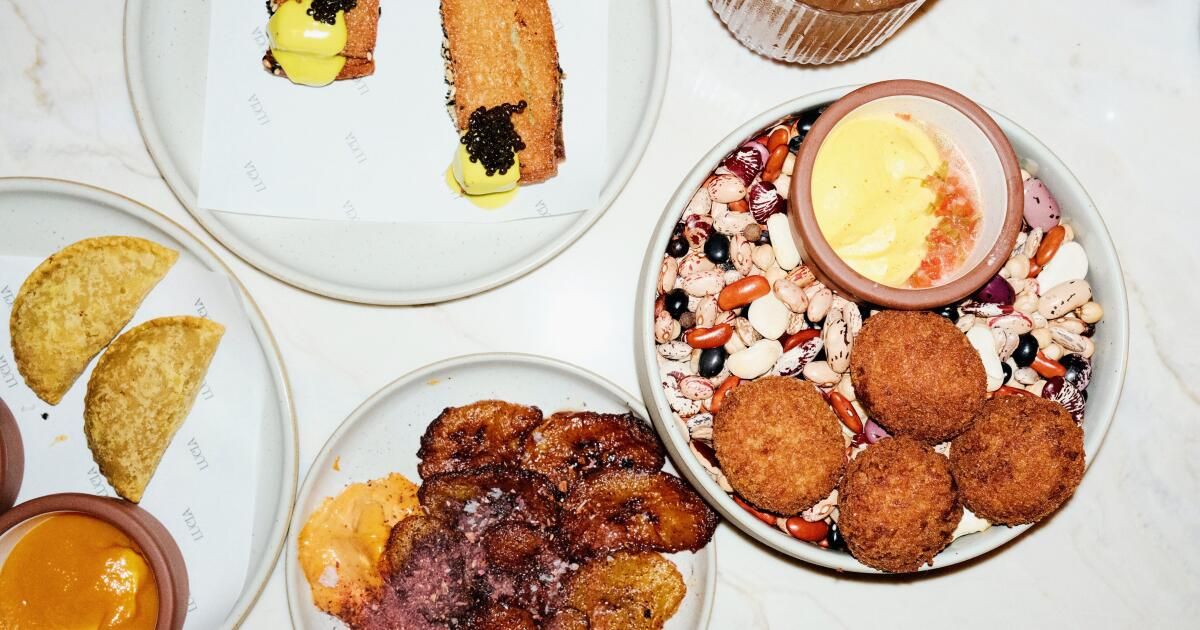In one of the new most anticipated restaurants in the city, diners delight in the Jamaican empanadas with rise and saline fish croquettes and figigüen while they sit in sculptural booths and in the form of a shell. An art installation in the form of a flower crown the bar in the center of the modern Afro-Caribeño restaurant. The Tomahawk fillets with Jerk spices and bananas soaked in an apero are heading to the tables while a DJ turns music until late at night. Lucia wants to bring flavors to the island, and Fairfax, at new heights.
“I knew how diverse and tasty and how impressive this kitchen could be if it is executed in this modern way that Adrian [Forte] He has taken it, “said owner Sam Jordan.” Comes from love for food and the opportunity to do something different in angels “
In the guyanés -style ox pepper pot of chef Forte, a dish that takes three days to do, the meat is covered with a mixture of domestic spices and smoked on Jamaican pepper wood, then stewed and served with a reduced sauce with Cassareep. The tender fried chicken is splashed with coconut milk and I did it with fermented chili alioli. Pepper Shrimp Toast, a wink to the jamaic crucible, combines the ubiquitous food from Camarones Fermented street with the Frito Chinese classic.
An art installation in the form of a flower crown the bar in the center of the modern Afro-Caribeño restaurant.
(Stephanie Breijo / Los Angeles Times)
“I really think our culture needs something like this,” Forte said. “Other cultures have all these different restaurants that are doing [their cuisines] at a high level and teaching chefs how to make this meal. But we don't have that in our culture, so it was very important for me and very useful. “
A great reason for this, he said, is the perception of value. Why could some diners pay $ 40 or $ 50 for a paste bowl, but not the oxen that takes three days to do? The Caribbean cuisine said, can and should exist in a price range.
“I was very inflexible about wanting to do this project … mainly only for culture so that they can see that it is possible, and they could see the perceived value, and we could stop undervaluating ourselves and our food,” he said.

Salado fish croquettes with Huancain and Creole sauce in Lucia.
(Stephanie Breijo / Los Angeles Times)
Another reason why Forte believes that Caribbean cuisine is not usually attempted in good food is that the accessibility of the ingredients.
Multiple chefs of the Caribbean restaurants told Forte that they could not find the fresh leafy green to make shut up and, therefore, they ordered him canned. But Forte noticed that many farmers in southern California use sweet potatoes and taro leaves as compost or as food for cattle; Now he buys it freshly out of farmers and serves as a quiet cream with grill pargo and a coconut butter sauce.
When looking for a acera, it goes to Latin markets for Hibiscus. When you look for the sweet potato or the Caribbean, you find the Japanese sweet potatoes easily. He buys bananas from a Vietnamese shopkeeper.
“I do not necessarily lack specific ingredients,” said Forte, “due to the interconnection of what we do as a whole. The diaspora is so vast, and we have all these synergies with different cultures that people do not even realize.”
The night service focuses on its small snacks and drinks supervised by Melina Meza drink director (previously from Level8, Boujis Group), which include a Martini Okra, a Tamarind Collins and an old ox. But Forte is also planning a new raw bar program inspired by the Caribbean, which also hopes to serve late at night.
The chef -born in Jamaica has deep culinary roots; His parents met at the shared restaurant of their own parents. Forte spent years of his childhood and adolescence in his kitchens, and when his father emigrated to Canada, Forte spent years traveling, having dinner and cooking in both countries. He participated in the eighth season of “Top Chef Canada”, as the first black contestant in the series, and helped launch multiple restaurants there.
When he met Jordan, Forte worked as a private chef on the Turkish and Caicos Islands. But Jordan's vision for Lucia attracted the chef and the author of the “Yawd” cookbook to Los Angeles.

Coconut fried chicken with fermented chili alioli, powdered coconut milk and pickles of the house in Lucia. An earlier version of this dish can be found in the 2022 cooking book of Forte, “Yawd: modern Afro-caribeño recipes.”
(Stephanie Breijo / Los Angeles Times)
After spending years investing in other people's restaurants in Los Angeles and the Bay area, Jordan, born in California, wanted to build his own business and attract his trips in the Caribbean to do so.
When Jordan moved to Los Angeles in 2016, he found a bustling fairfax full of art, street style and creators of flavor. The pandemic closed multiple showcases along the iconic stretch, but the restorer hopes that Lucía, to open in the old Black Star hamburger space, can help stimulate revitalization on the street.
He and the preen design firm took out of the Flora and Fauna from the Caribbean for the interior, asking the artist Guerin Swing to launch the rows of the “shell cabins” and the imposing sculpture of concrete flower bars.
“The whole place is like a show,” Jordan said. “When you look around, you see the big flowers in the center, you see the shell cabins; the rear dining room area is beautiful with the mirrors, everything. A large part of the food and the cultures that inspire our restaurant is the idea that we are not trying to hurry anyone. We want people to feel comfortable, order food, go out, spend the time, listen to the music.
Lucia is open from Wednesday to Sunday from 6 pm at midnight in 351 N. Fairfax Ave., Los Angeles, (213) 800-0048, Luciala.com












